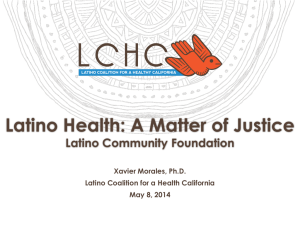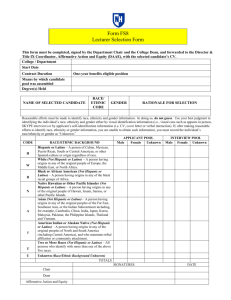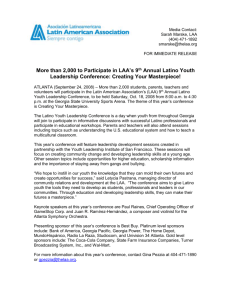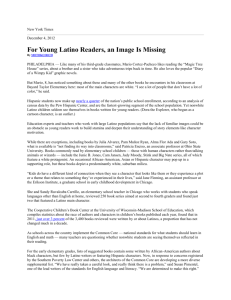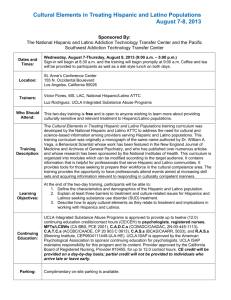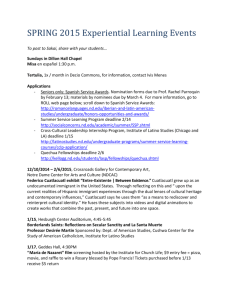Course Outline - US Latina/o Studies Program
advertisement
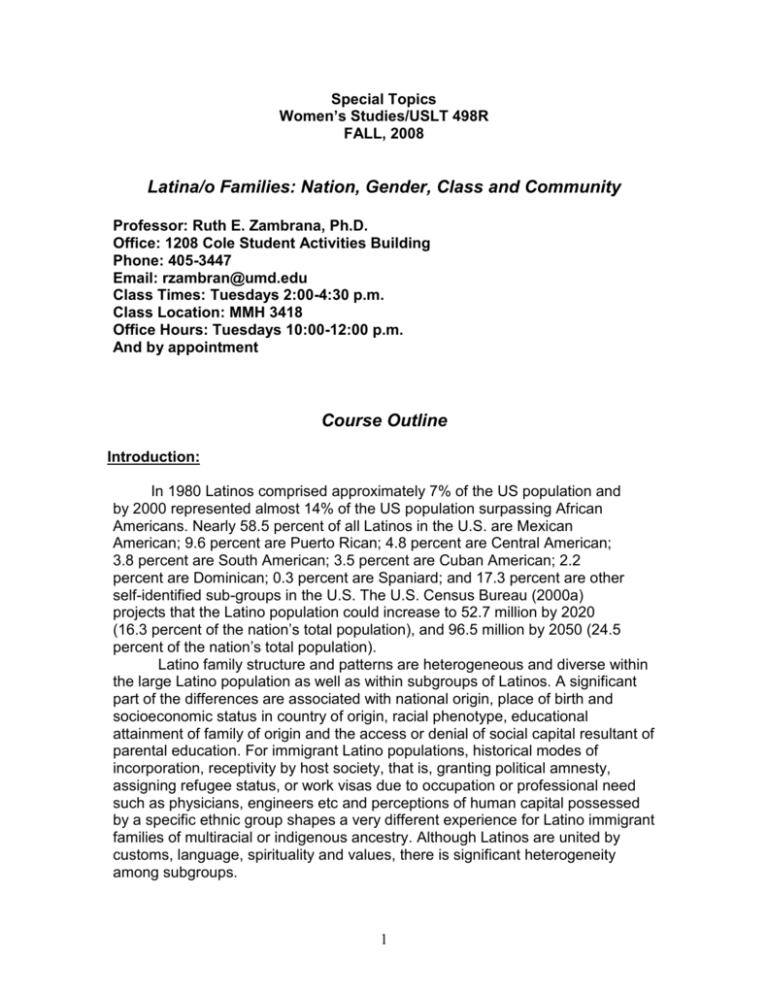
Special Topics Women’s Studies/USLT 498R FALL, 2008 Latina/o Families: Nation, Gender, Class and Community Professor: Ruth E. Zambrana, Ph.D. Office: 1208 Cole Student Activities Building Phone: 405-3447 Email: rzambran@umd.edu Class Times: Tuesdays 2:00-4:30 p.m. Class Location: MMH 3418 Office Hours: Tuesdays 10:00-12:00 p.m. And by appointment Course Outline Introduction: In 1980 Latinos comprised approximately 7% of the US population and by 2000 represented almost 14% of the US population surpassing African Americans. Nearly 58.5 percent of all Latinos in the U.S. are Mexican American; 9.6 percent are Puerto Rican; 4.8 percent are Central American; 3.8 percent are South American; 3.5 percent are Cuban American; 2.2 percent are Dominican; 0.3 percent are Spaniard; and 17.3 percent are other self-identified sub-groups in the U.S. The U.S. Census Bureau (2000a) projects that the Latino population could increase to 52.7 million by 2020 (16.3 percent of the nation’s total population), and 96.5 million by 2050 (24.5 percent of the nation’s total population). Latino family structure and patterns are heterogeneous and diverse within the large Latino population as well as within subgroups of Latinos. A significant part of the differences are associated with national origin, place of birth and socioeconomic status in country of origin, racial phenotype, educational attainment of family of origin and the access or denial of social capital resultant of parental education. For immigrant Latino populations, historical modes of incorporation, receptivity by host society, that is, granting political amnesty, assigning refugee status, or work visas due to occupation or professional need such as physicians, engineers etc and perceptions of human capital possessed by a specific ethnic group shapes a very different experience for Latino immigrant families of multiracial or indigenous ancestry. Although Latinos are united by customs, language, spirituality and values, there is significant heterogeneity among subgroups. 1 Course Description: The course provides an overview of the diverse Latino family forms in the US, and examines family structure and patterns and their influence on family functioning and individual development by gender, class and nation. The course objectives are to have students: (1) become informed on the heterogeneity within and among Latino subgroups; (2) become familiar with the contemporary theoretical discourse on understanding the position of Latino families in US society; (3) understand the interplay of ethnicity, race, gender and class in the functioning of Latino women and families; (4) examine the key social and policy issues that differentially impact Latino women and families; and (5) gain an indepth understanding of a specific aspect of Latino families or a subgroup through a final term paper. REQUIRED TEXTBOOK: Ruth E. Zambrana, Heterogeneity and Transformation in Latino Families: Role of National Origin, Gender, and SES (manuscript under review) Kurt C. Organista, (2007) Solving Psychosocial and Health Problems: Theory, Practice and Populations, Hoboken New Jersey: John Wiley and Sons. Websites: Pew Hispanic Center: http://pewhispanic.org/ US Census Bureau: http://www.census.gov/acs/www/ Course Requirements and Expectations: OFFICE HOURS: I will require a formal meeting with each student at the start of the semester. Additionally, please come and speak with me if you have any questions or concerns- don’t wait until the last minute! IMPORTANT: All written assignments must be typed, double-spaced and 12pt. Font (Times and Times New Roman are the only acceptable font styles). Use APA style format as presented in the Publication Manual 5th Edition. Washington, DC: American Psychological Association. It is expected that all assignments submitted will be paginated, proofread, spell-checked and adhere to grammatical standards. Please note: Emailed submissions are NOT acceptable. A paper that does not adhere to these standards may lose up to 10 points. Use standard spacing and margins. Multiple page submissions should be stapled or well-bound together. 2 ASSIGNMENTS: Students are responsible for all assigned readings. Read PRIOR to the assigned class time. Class lectures and discussions will cover material supplemental to the readings, in addition to guiding you through them. Assignments are due on the date scheduled. You are encouraged to consult with me at any time for assistance and ideas on improving your performance. LATE ASSIGNMENTS: Late assignments will drop one letter grade-level (1 day late a B+ assignment converts to a C+) per day they are late from the original due-date. Being absent from class does not excuse you from having a hardcopy of your assignments delivered at the appropriate time (do not send via email). CLASS PARTICIPATION AND BEHAVIOR: Active participation is required and will be considered in the assignment of final grades. This participation includes: coming to class prepared (having read and thought about the reading and having completed assignments in hand); being ready to begin class on time (arriving on time, putting unrelated materials away, ending conversations, etc.); responding to instructor questions, contributing to class discussion, and asking thoughtful questions; listening attentively and respectfully to all class members; participating in individual and group exercises; and contributing to harmony in the classroom (not monopolizing class discussion and not acting in a disruptive manner, for example, but showing good will toward others, offering some humor when appropriate, coming to the instructor with questions or concerns, etc.). In a word, it comes down to respect. If you are not present in class, you cannot participate and learn. Just as the instructor is responsible for facilitating, monitoring, evaluating, and contributing to this process, students are responsible for fully and seriously participating in the course. EMAIL: You are required to keep your email account current. At times throughout the semester I may be sending assignments and/or messages to the class or to specific individuals. Please be aware emailed assignments are not acceptable. ABSENCES: If you miss two classes you are encouraged to drop the course. Attendance will be taken at each class meeting. Absence is at times unavoidable; nonetheless your grade is likely to suffer. Students will not be penalized because of observances of their religious beliefs; students shall be given an opportunity, whenever feasible, to make up within a reasonable time any academic assignment that is missed due to individual participation in religious observances. It is the student’s responsibility to inform the instructor of any intended absences for religious observances by the end of the Schedule Adjustment period. University Policies: 1. Students with disabilities should contact the instructor at the beginning of the semester to discuss any accommodation for this course. 3 2. The University has approved a Code of Academic Integrity which prohibits students from cheating on exams, plagiarizing papers, submitting the same paper for credit in two courses without authorization, buying papers, submitting fraudulent documents, and forging signatures. Plagiarism policy: all quotations taken from other authors, including from the Internet, must be indicated by quotation marks and referenced. Paraphrasing must be referenced as well. The following University of Maryland Honor Pledge has been proposed by the Council and approved by the University Senate: "I pledge on my honor that I have not given or received any unauthorized assistance on this assignment/examination." This pledge should be handwritten and signed on the front page of all papers, projects or other academic assignments submitted for evaluation in this course. 3. Religious observance: Please inform your instructor of any intended absences for religious observance in advance. 4. This syllabus may be subject to change. Students will be notified in advance of important changes that could affect grading, assignments, etc. Course Assignments: 1. Participation Class sessions are essential to maximizing your learning in this course. Each student is expected to have read all assigned class readings prior to class and to actively participate and contribute to class discussion. Students are encouraged to provide different perspectives in a respectful and intellectually challenging manner. (10%) 2. Each student will be required to complete three response papers on the required readings. You are expected to summarize the major themes or facts learned from the readings, analyze and respond within the context of the class lectures and discussion. These are about 3 typewritten pages each. These will be due after each of 4 class sessions. Dates are noted on the course outline (30%). 3. Each student will be required to work with a partner to read the assigned articles and serve as discussion leader. The leader(s) are expected to highlight 3-5 important issues from the readings and to develop 3-5 discussion questions to stimulate participation of students. (10%). 4. Each student is required to select a topic for their final/term paper by the second week of class. 4 These term papers are designed to provide you with an in-depth knowledge of some aspect of family functioning of a specific Latino subgroup. Topics may include Mexican American girls and educational achievement, Puerto Rican women and public assistance, Mexican American youth and gang membership, Resiliency in Mexican American children; Factors that influence gender roles in Latino subgroups. Each student will be assigned a 15 minute time to present a discussion of their paper during the last 4 weeks of class (20%). 5. Submit a written final/term paper at the end of the semester. This paper will include a brief demographic description of the subgroup by age, gender, geographic location, education, income and occupations. Required is a conceptual approach to understanding the family dynamics of the group, review of major findings for topic under study, and discuss how these findings help us to better understand that particular area of Latino families. The paper should be about 10 pages in length. You will be expected to have at least 5 empirical references from journals. (30%). Grading Participation Response Paper Discussion Leader Class Presentation Final Research Paper 10% 30% 10% 20% 30% 100% COURSE OUTLINE Topic Readings September 2 Introduction and Overview Why study Latino Families? Zambrana, Chapter 1 September 9 Latina/os: Who are They? Organista, Chapter 1 Zambrana, Chapter 2 September 16 Latino Identity And Nation Organista, Chapters 2-3 September 23 Theory in the Study of Latino Families Organista, Chapter 6 Zambrana, Chapter 3 Response Paper DUE 5 September 30 Family Development: Role Of Poverty & Culture Organista, Chapters 2, 3 and 4 Zambrana, Chapter 4 October 7 Girls to Women Zambrana, Chapter 5 October 14 Boys to Men Organista, Chapter 7 Zambrana, Chapter 6 October 21 Latina/o Health Organista, Chapter 9 Zambrana, Chapter 7 Response Paper DUE October 28 Mental Health Organista, Chapter 8 November 4 Public Service Systems: Policy and Latinos November 11 Latinos, Practice in the Community, and Civic Participation November 18 Heterogeneity and Representation of Latino Families Zambrana, Chapter 9 Organista, Chapters 5 and 10 Zambrana, Chapters 9 and 10 Response Paper DUE November 25 Latino Women: Role of Work and Family Student Presentations December 2 Latino Children & Youth: Impact Of Family & Community Student Presentations December 9 Student Presentations Policy & Research Directions The final/term paper is due at my office, no later than Friday, December 19, by noon. 6 Recommended Readings Acosta-Belen, E. & Santiago, C.E. (1998). Merging borders: the remapping of America. In A. Darder & R.D. Torres (eds.), The Latino studies reader: culture, economy, and society (pp.29-42). Malden, MA: Blackwell Publishers. Zambrana, R.E. & Dorrington C. (1998). Economic and social vulnerability of Latino children and families by subgroup: implications for child welfare. Child Welfare, Vol. LXXVII (1), 6-27. Lichter, D.T. & Landale, N.S. (1995). Parental work, family structure, and poverty among Latino children. Journal of Marriage and the Family (57), 346354. Garcia-Coll, C.T. (1990). Developmental outcome of minority infants: a process-oriented look into our beginnings. Child Development (61), 270-289. Baca-Zinn, M. (1994). Feminist rethinking from racial-ethnic families. In M. Baca-Zinn & B. Thornton-Dill (eds), Women of color in US society (pp. 303314). Philadelphia, PA: Temple University Press. Rodriguez, G.G. (1999). Bringing up Latino children in a bicultural world. New York: Simon & Schuster. Gonzalez-Ramos, G., Zayas, L.H. & Cohen, E.V. (1998). Child-rearing values of low-income, urban Puerto Rican mothers of preschool children. Professional Psychology: Research & Practice 29(4): 377-382. Gandara, P. (1995). Over the ivy walls: the educational mobility of lowincome Chicanos. Albany, NY: State University of New York Press. Casas J.M., Wagenheim, B.R., Banchero, R. & Mendoza-Romero, J. (1995). Hispanic masculinity: myth or psychological schema meriting clinical consideration. In A. Padilla (editor), Hispanic Psychology: Critical Issues in Theory & Research. (pp. 231-244). Thousand Oaks, CA: Sage Publications. COSSMHO. (1999). The state of Hispanic girls. Washington, DC: COSSMHO. Perez-Stable, M. & Uriarte, M. (1993). Cubans and the changing economy of Miami. In R. Morales & F. Bonilla (eds), Latinos in a Changing US Economy. (pp.133-159). Thousand Oaks, CA: Sage Publications. 7 Zambrana, R.E. (1994). Puerto Rican Families and social well-being. In M. Baca-Zinn & B. Thornton-Dill (eds), Women of color in US society (pp. 133146). Philadelphia, PA: Temple University Press. Reyes P. & Valencia, R.R. (1995). Educational policy and the growing Latino student population. In A. Padilla (editor), Hispanic Psychology: Critical Issues in Theory & Research. (pp. 303-325). Thousand Oaks, CA: Sage Publications. 8



